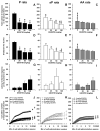Comparison of the effect of the GABAΒ receptor agonist, baclofen, and the positive allosteric modulator of the GABAB receptor, GS39783, on alcohol self-administration in 3 different lines of alcohol-preferring rats
- PMID: 22486245
- PMCID: PMC3396797
- DOI: 10.1111/j.1530-0277.2012.01782.x
Comparison of the effect of the GABAΒ receptor agonist, baclofen, and the positive allosteric modulator of the GABAB receptor, GS39783, on alcohol self-administration in 3 different lines of alcohol-preferring rats
Abstract
Background: Administration of the GABA(B) receptor agonist, baclofen, and positive allosteric modulator, GS39783, has been repeatedly reported to suppress multiple alcohol-related behaviors, including operant oral alcohol self-administration, in rats. This study was designed to compare the effect of baclofen and GS39783 on alcohol self-administration in 3 lines of selectively bred, alcohol-preferring rats: Indiana alcohol-preferring (P), Sardinian alcohol-preferring (sP), and Alko Alcohol (AA).
Methods: Rats of each line were initially trained to respond on a lever, on a fixed ratio (FR) 4 (FR4) schedule of reinforcement, to orally self-administer alcohol (15%, v/v) in daily 30-minute sessions. Once responding reached stable levels, rats were exposed to a sequence of experiments testing baclofen (0, 1, 1.7, and 3 mg/kg; i.p.) and GS39783 (0, 25, 50, and 100 mg/kg; i.g.) on FR4 and progressive ratio (PR) schedules of reinforcement. Finally, to assess the specificity of baclofen and GS39783 action, rats were slightly food-deprived and trained to lever-respond for food pellets.
Results: The rank of order of the reinforcing and motivational properties of alcohol was P>sP>AA rats. Under both FR and PR schedules of reinforcement, the rank of order of potency and efficacy of baclofen and GS39783 in suppressing alcohol self-administration was P>sP>AA rats. Only the highest dose of baclofen reduced lever-responding for food pellets; this effect was common to all 3 rat lines. Conversely, no dose of GS39783 altered lever-responding for food in any rat line.
Conclusions: These results suggest that: (i) the strength of the reinforcing and motivational properties of alcohol differ among P, sP, and AA rats; (ii) the reinforcing and motivational properties of alcohol in P, sP, and AA rats are differentially sensitive to treatment with baclofen and GS39783; (iii) the heterogeneity in sensitivity to baclofen and GS39783 of alcohol self-administration in P, sP, and AA rats may resemble the differential effectiveness of pharmacotherapies among the different typologies of human alcoholics; and (iv) the GABA(B) receptor is part of the neural substrate mediating the reinforcing and motivational properties of alcohol.
Copyright © 2012 by the Research Society on Alcoholism.
Figures




References
-
- Addolorato G, Caputo F, Capristo E, Colombo G, Gessa GL, Gasbarrini G. Ability of baclofen in reducing alcohol craving and intake: II – Preliminary clinical evidence. Alcohol Clin Exp Res. 2000;24:67–71. - PubMed
-
- Addolorato G, Caputo F, Capristo E, Domenicali M, Bernardi M, Janiri L, Agabio R, Colombo G, Gessa GL, Gasbarrini G. Baclofen efficacy in reducing alcohol craving and intake – A preliminary double-blind randomised controlled study. Alcohol Alcohol. 2002a;37:504–508. - PubMed
-
- Addolorato G, Caputo F, Capristo E, Janiri L, Bernardi M, Agabio R, Colombo G, Gessa GL, Gasbarrini G. Rapid suppression of alcohol withdrawal syndrome by baclofen. Am J Med. 2002b;112:226–229. - PubMed
-
- Addolorato G, Leggio L, Abenavoli L, DeLorenzi G, Parente A, Caputo F, Janiri L, Capristo E, Rapaccini GL, Gasbarrini G. Suppression of alcohol delirium tremens by baclofen administration: a case report. Clin Neuropharmacol. 2003;26:258–262. - PubMed
-
- Addolorato G, Leggio L, Abenavoli L, Agabio R, Caputo F, Capristo E, Colombo G, Gessa GL, Gasbarrini G. Baclofen in the treatment of alcohol withdrawal syndrome: a randomized comparative study versus diazepam. Am J Med. 2006;119:276.e13–276.e18. - PubMed
Publication types
MeSH terms
Substances
Grants and funding
LinkOut - more resources
Full Text Sources
Medical
Research Materials

